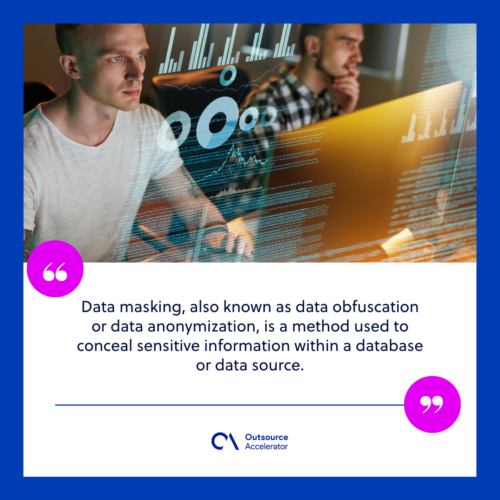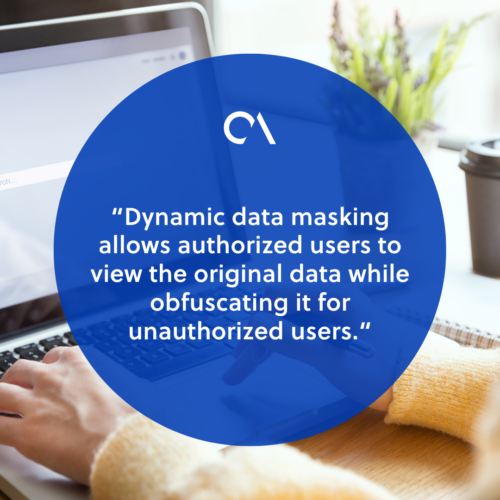Data masking: Types, cases, and techniques

If you’re working in a tech industry or any business that handles lots of data, then you know that the growing sophistication of cyberattacks poses significant challenges.
The expansion of data privacy regulations, such as the GDPR and CCPA, adds another layer of complexity. Businesses are required to adhere to strict guidelines regarding the collection, storage, and processing of personal data.
Failure to address these concerns effectively can undermine consumer trust and hinder business growth for tech companies operating in data-intensive environments.
This is one of the reasons why data masking is important and considered by many enterprises as a critical component of their data security strategies.
What is data masking?
Data masking, also known as data obfuscation or data anonymization, is a method used to conceal sensitive information within a database or data source.
The primary objective of data masking is to ensure that confidential data remains protected while retaining its usability for authorized purposes.
This enables organizations to share and utilize data for testing, development, or analysis without compromising privacy or security.

Why is data masking important?
Data masking is important for safeguarding sensitive information by anonymizing sensitive data within databases or data sources. It ensures that even if a breach occurs, the compromised data remains inaccessible to unauthorized users.
Here are other reasons why this method is crucial for businesses working with a heavy amount of data:
- Compliance – Compliance with data protection regulations such as HIPAA or PCI DSS mandates the implementation of data masking to safeguard sensitive information.
- Trust and reputation – Using this method effectively demonstrates a commitment to data privacy and security, enhancing trust among stakeholders.
- Operational efficiency – Data masking facilitates secure data sharing for various purposes, including software testing and outsourcing, without impeding operational efficiency.
Types of data masking
Let’s explore the different types of data masking and their significance in ensuring data security and compliance.
Static data masking
Static involves permanently altering sensitive data within the data source. This is typically implemented during the initial setup, where sensitive data fields are replaced with fictitious but realistic values.
Unlike dynamic or on-the-fly masking, static data masking applies changes to the entire dataset and is generally irreversible.
This is well-suited for scenarios where the original data does not need to be accessed or restored, such as archival or historical datasets.
Dynamic data masking
Dynamic data masking allows authorized users to view the original data while obfuscating it for unauthorized users.
This technique is effective in scenarios where data needs to be accessible but must remain protected, such as in multi-user environments or web applications.

On-the-fly data masking
On-the-fly data masking applies masking techniques as data is accessed or retrieved from the database.
Unlike static masking, which applies changes permanently to the dataset, this ensures that sensitive data is protected during transmission and while in use without altering the original dataset.
This approach is particularly useful in environments where real-time data access is required, such as online transaction processing or interactive data analytics.
Use cases of data masking
Data masking finds applications across various industries and scenarios to address specific privacy and security requirements.
Some common use cases include the following:
- Data protection compliance – By anonymizing or pseudonymizing sensitive data, organizations can ensure compliance while maintaining data usability.
- Outsourcing and offshoring – Data masking enables secure data sharing, allowing organizations to protect confidential information while outsourcing tasks such as customer support or software development.
- Software development and testing – Using actual production data for testing purposes can pose significant security risks. Data masking enables the creation of realistic yet secure test datasets.
Data masking techniques to use
Here are some of the most commonly used data masking techniques:
Masking out
Masking out involves replacing sensitive data with fictitious but realistic values.
One example of this technique is replacing actual names with randomly generated names or substituting credit card numbers with fake credit card numbers.
This ensures that the data remains usable for testing or analysis while protecting individual identities and financial information.
Nullifying
Nullifying involves replacing sensitive data with null values or empty strings, rendering the original data unreadable.
While this protects sensitive information, it may impact data integrity and usability in certain scenarios. Before applying this data masking technique, assess the dependencies and relationships between data elements within the dataset.
Shuffling
Shuffling involves the randomization or reordering of sensitive data elements.
In this process, the original values of sensitive attributes, such as names, addresses, or identifiers, are replaced with randomly selected values from the same data domain.
For example, in a dataset containing customer names and addresses, shuffling would randomly reassign each customer’s name to a different address and vice versa.
This ensures that the relationship between individuals and their personal information is concealed, making it difficult for unauthorized users to identify specific data records.
Date aging
Date aging involves adjusting date-based information, such as birthdates or transaction dates, to obscure the original timeline while preserving the relative relationships between data points.
By aging dates forward or backward within a realistic range, organizations can protect temporal information without compromising data integrity or usability.
Overall, by understanding data masking’s use cases and techniques, you can effectively safeguard your data while ensuring compliance and maintaining operational efficiency.







 Independent
Independent




